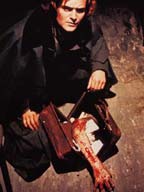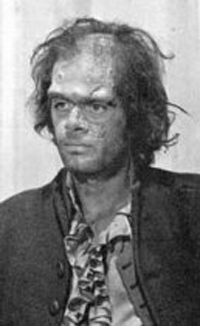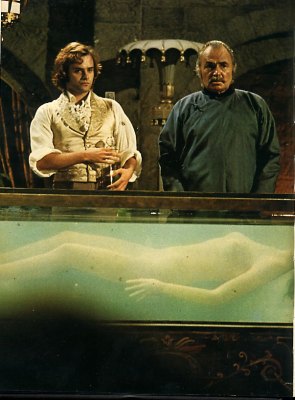| Reviews & Columns |
|
Reviews DVD TV on DVD Blu-ray 4K UHD International DVDs In Theaters Reviews by Studio Video Games Features Collector Series DVDs Easter Egg Database Interviews DVD Talk Radio Feature Articles Columns Anime Talk DVD Savant Horror DVDs The M.O.D. Squad Art House HD Talk Silent DVD
|
DVD Talk Forum |
|
|
| Resources |
|
DVD Price Search Customer Service #'s RCE Info Links |
|
Columns
|
|
|
Frankenstein: The True Story

Seeing the film today, I was most taken with the literate, searching, intricate screenplay by Christopher Isherwood and Don Bachardy, with its unusual take on the Mary Shelley novel. Despite the title, Frankenstein: The True Story is not a literal translation of Shelley's classic. Basic themes of Shelley are included in the story (as they were in other earlier Frankenstein films, particularly the 1931 version), with some Shelley plot elements (such as the Creature created beautiful, and the climax occurring in the Arctic) appearing for the first time in a Frankenstein movie. Taking the basic framework of the Shelley novel, Isherwood and Bachardy fashioned a tense dialogue of science versus religion, ego versus love, passion versus duty, and most importantly, beauty versus ugliness.
As students of the book know, its impetus came during a sojourn near Lake Geneva, Switzerland, in 1816, when Mary Wollstonecraft, her finance, poet Percy Byshe Shelley, and fellow poet Lord Byron suggested a competition for all to write a horror story. Eventually, the most famous result of that dare became Mary Shelley's novel, Frankenstein. Revolutionary at the time for a woman writer questioning the relationship between God and his creation, her story has continued to intrigue the imaginations of readers to this day, and has been adapted, borrowed (and often mangled) by countless other authors, stage producers, and filmmakers.
Here are the bare bones of the new Frankenstein story as created by Isherwood and Bachardy (I won't include any major spoilers). Dr. Victor Frankenstein (Leonard Whiting), filled with "blasphemy" against the religious and moral times he lives in (aggravated by the senseless drowning death of his brother), single-mindedly pursues his desire to compete with God, by not just creating life from whole cloth, but by actually bringing the dead back to life. He essentially abandons his fiancé Elizabeth (Nicola Pagett) to take up with dissipated, anti-religious, brilliant Henry Clerval (David McCallum) in his experiments to bring life to dead flesh. After seeing Clerval's successful experiments (such as an amputated arm kept alive for over a month, and a dead beetle resurrected), he aids Clerval in assembling body parts to make a complete human creature.
On the eve of the creature's rebirth, Clerval discovers that the process has not been perfected. Henry, fatally stricken with an unnamed illness, tries to send a message to Victor that the process is flawed, but death takes him before he can succeed. Victor, failing to decipher Henry's message, decides that Henry's brain is the perfect, final puzzle piece for his creation. In a departure from previous films (but true to the novel), the Creature (Michael Sarrazin, quite affecting here) comes to life in full Byronic beauty. He is also a blank slate and perfect mimic; he is gradually trained to appreciate beauty and culture. But before he can finish his training, the inevitable decay of the flawed process begins, and Victor, disgusted by what he has wrought, rejects his creation, and by his example, teaches the Creature hatred, shame, and violence. Filled with feelings of self-loathing he cannot understand, The Creature tries to commit suicide, but finds he is immortal.
At this point, the shadowy figure of Polidori (James Mason, brilliant as usual, in a role created specifically for this version) takes the place of the departed Henry. Seeking vengeance against Henry (Polidori knows the Creature has his brain), who worked with Polidori and who, according to Polidori, stole his secrets of resurrecting the dead, Polidori enlists the aid of the Creature to help blackmail newly married Victor, into helping create his own female monster, Prima (Jane Seymour). Events go disastrously wrong, and eventually, Victor and the Creature must work out their fate at the top of the globe.

Isherwood and Bachardy, both film enthusiasts, felt that no movie version had really done justice to the original source material. In particular, the writers felt the relationship between Creator and Creation, and the various levels of interaction between the two (including themes of implied homosexuality, incest, and androgyny) that Shelley suggested, needed to "come out," so to speak, in this version.
Isherwood, an openly gay writer, placed particular emphasis in the script (which co-writer Bachardy readily admitted was largely written by Isherwood) on the gay subtext which Isherwood felt was inherent in the novel. Victor abandons Elizabeth three times to be in the company of other men -- the third time the night of his unconsummated honeymoon, no less. First, finding no comfort in Elizabeth (who represents strict religion and moral conformity) when his brother drowns, he runs to Henry, who mirrors his doubts in religion, and allows him to pursue his true goals of playing God -- without the stringent disapproval of Elizabeth. With Henry, who, significantly, demands that the monster be beautiful, Victor finds a true counterpart to his passions, and builds a satisfying relationship with Henry. Elizabeth, when she visits Victor, sees the depth to which Henry and Victor have bonded. Rejecting their efforts as blasphemous (she is sickened by their resurrected butterfly), she demands he chooses her or Henry. Victor chooses Henry. She reacts as any man would be expected to, wishing she could get back at Victor for his emotional betrayal, by killing her rival, Henry.
Second, once Victor has placed Henry's brain in the Creature's body, he utterly forgets about Elizabeth as he enjoys a relationship with his Creature that is, in almost every way, a "marriage" (which also brings up elements of incest as well, since Victor is also "father" to the creature). When the Creature is born, both he and Victor comment on how beautiful they both are (Sarrazin's clingy little gauze bandage outfit only emphasizes the sexual nature of his relationship with Victor -- shades of The Rocky Horror Picture Show???). After the solar conflagration that brings the Creature to life, they both move towards each other, to remove the coverings from each other's eyes, so that they may see each other for what they really are -- soulmates. Later, the sophisticated Victor takes particular pleasure in exposing his gorgeous, naive student/creation to all the cultured delights of romantic London, culminating in a date at the opera where Victor can show off his love -- a Pygmalion theme not at all unusual in gay texts and works. They live in close quarters, obviously enjoying each other's sole company immensely. Indeed, Elizabeth doesn't even factor into this particular section of the story.
And third, on his honeymoon night, before he can even consummate his marriage to Elizabeth, Victor leaves Elizabeth to join Polidori. He may cry blackmail, but obviously, he does little to fight his desire to "get it right" this time in creating a perfect specimen. Without spoiling the end of the film, it's quite apparent in the denouement what Isherwood wanted to say about Victor's and the Creature's feelings for each other.
This is not to say that Frankenstein: The True Story abandons its horror roots to give the audience a thinly disguised political tract. In no way does Isherwood's emphasis on the sexual underpinnings of the story slight the horror elements of the film. There's a suitably gothic feel to the proceedings, courtesy of cinematographer Arthur Ibbetson's moody, naturalistic lighting, and production designer Wilfrid Shingleton's opulent sets. The music by Gil Melle strikes the proper grand manner, while the special effects by Roy Whybrow are more than up-to-par for a television production in 1973 (other sources, including the DVD case, list Hammer legend Roy Ashton as doing the makeup, but his name does not appear in the credits). And while the action may seem tame by today's standards (I suspect, due to some rough editing, that some extra shots of gore were filmed, but excised from the American television showing -- particularly a notorious scene with Jane Seymour), there's some impressive moments of special effects, particularly the disembodied, crawling arm, and Prima's reincarnation scene, complete with her decapitated nude body in giant vat of colored water and Fizzies.

The pace is somewhat stately, and the director, Jack Smight (Harper, The Illustrated Man) doesn't do much in the way of interesting compositions (limited by shooting for the television screen, perhaps), but Frankenstein: The True Story still manages to hold our interest over its three hour length. The acting is first-rate for a television production; particularly noteworthy is the magnificently snotty James Mason as Polidori. Mason's every line reading is an indictment against the mere mortals who act along side him; he's a delight, playing the nasty, effete kind of role he came to specialized in. The modern day prologue, with Mason addressing the audience, is hysterical. Who else but Mason could give the audience a brief, helpful introduction to the film, while simultaneously talking down to them? Also affecting is Michael Sarrazin as the Creature; he's uncommonly good at getting across the Creature's innocent, pathetic nature, as well as his growing, inevitable homicidal tendencies. It's nice to see lady-like Jane Seymour as a vicious, catty vamp -- watch her try to strangle that cat! She should have played more villains in her career.
A major change to the film came after it was shot, which undercut the carefully integrated themes of Isherwood's script. Originally, there was a prologue filmed that had Mary Shelley telling her story of Frankenstein, with Percy Shelley, Lord Byron and Polidori (who was a real person -- he was Lord Byron's doctor and actually the author of the first vampire story in English), acting out the characters of Victor, Henry and the Creature, and Polidori. All the themes of the screenplay were introduced in this prologue, including the prevalent use of mirrors to illustrate dual natures, and the butterfly motif that would be crucial later in the story. For whatever reason, NBC decided to cut this prologue from the final print, and quickly film a modern day introduction/preview, with James Mason, in modern London and at Shelley's grave site, addressing the audience. This new prologue is The DVD: The Video: The Audio: The Extras: Final Thoughts:
Although the studio notes on the back of the case state that this three hour version is unedited, I have my doubts. I distinctly remember scenes that were not included in this disk. It's difficult to discuss them, without creating spoilers for you, the reader of this review, but please email if you'd like to discuss it, or if you have memories of scenes that aren't included in this disc, either. As well, the quality of the print is terrible. Either no effort was made to go to the original film elements, or they were unavailable for this DVD. The credits list Panavision equipment; at the very least, the film was shot at a 1.66:1 ratio, and more probably at 1.85:1. The film, drastically cut by over an hour, was shown theatrically in Europe, so one might assume that the film was shot in some form of widescreen (it may have been matted or cropped, though). However, this DVD is full frame. I'm a purist, so I don't particularly mind that it's full frame -- after all, that's how it was originally shown here in the States. But if it was possible to present it in widescreen, they should have offered that option on the DVD. As well, the print used for this transfer is terrible; I'm guessing they used the original video master, from a faded, grainy print, that was used for the original video release back in the early 80s. The muted, faded colors range from muddy browns to fading pink. Scratches, dirt and specks also appear.
You better turn it up to 50. The English Dolby Digital 2.0 mono has been recorded at an extremely low level. Frankly, it sounded better on our little TV speaker when I was a kid.
There are no extras, unless you count the ridiculous "prologue" that blows the whole movie right at the beginning, or the "Sneak Peaks" of DVD offerings from Universal, like Fear Factor and Coach. Remember: go past that prologue before you watch the film!
Frankenstein: The True Story is a fascinating, rewarding take on the much-reworked Shelley classic. The performances are uniformly fine, and the production is appropriately lush for the epic dimensions. However, the disc presentation is at best, barely adequate, with an only fair picture, and poor sound quality. Horror completists will want it for their collection, and overall, will be satisfied with their purchase; curious newcomers to the film should rent it first.
Paul Mavis is an internationally published film and television historian, a member of the Online Film Critics Society, and the author of The Espionage Filmography.

|
| Popular Reviews |
| Sponsored Links |
|
|
| Sponsored Links |
|
|
| Release List | Reviews | Shop | Newsletter | Forum | DVD Giveaways | Blu-Ray | Advertise |
|
Copyright 2024 DVDTalk.com All Rights Reserved. Legal Info, Privacy Policy, Terms of Use,
Manage Preferences,
Your Privacy Choices | |||||||















